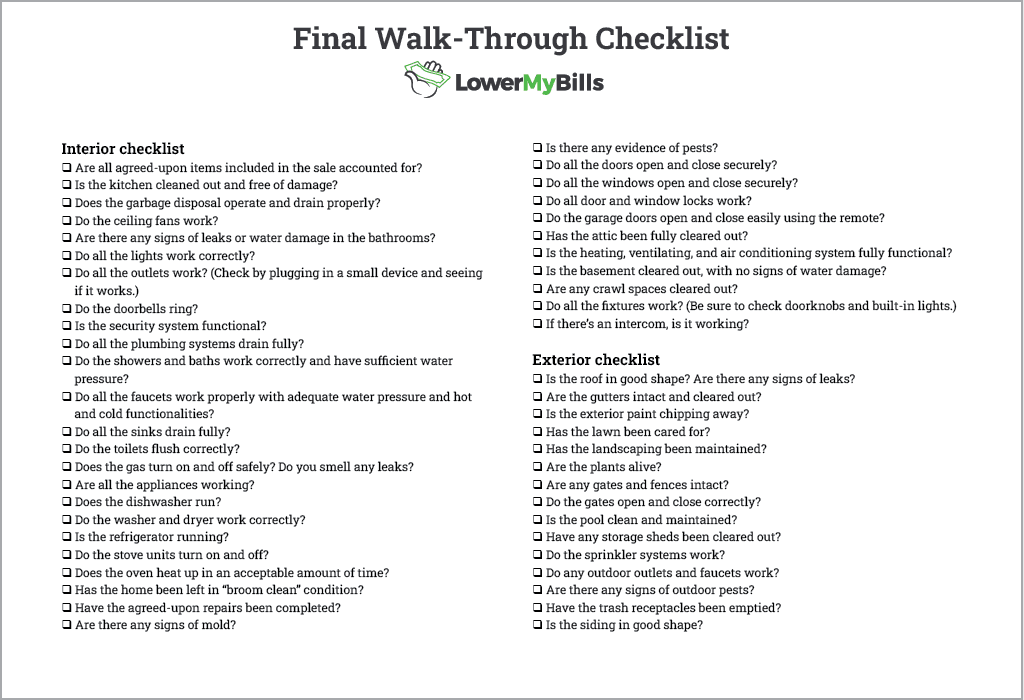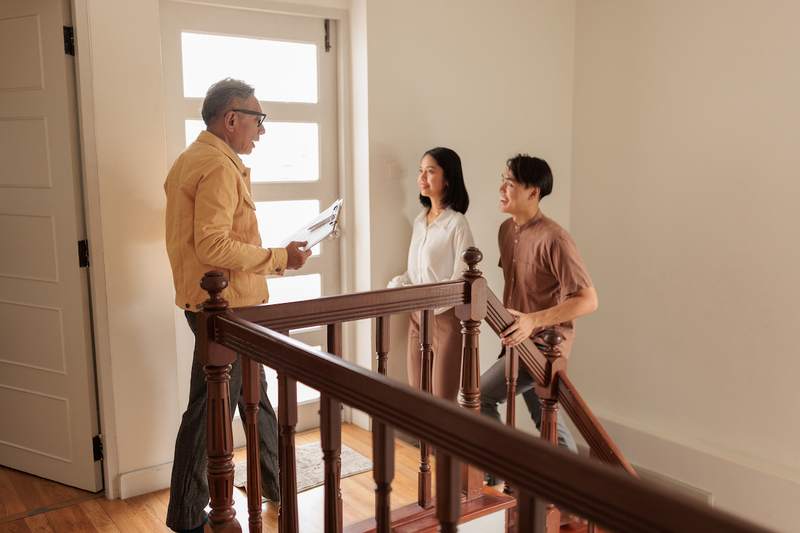The final walk-through is one of the most important steps in the homebuying process — especially for first-time homebuyers — because it’s your final chance to inspect the property before it becomes yours.
The final walk-through should confirm that the property is in the expected condition and any agreed-upon repairs or alterations have been made. It’s helpful during this process to have a home walk-through checklist.
Because a home is a major investment, you’ll want to be prepared and know what to look for in the final house walk-through.
Key Takeaways:
- The final walk-through timeline varies based on the size of the home and how thorough you are in inspecting the home.
- You should bring an interior checklist and an exterior checklist to the final walk-through.
- It’s important to address any problems you find during the final walk-through. As a last resort, you may have to back out of the home purchase.
What Is a Walk-Through?
During the final walk-through, you and your real estate agent will inspect the property before closing on the home. This usually is the last chance to confirm the condition of the house before the sale is finalized.
It’s important to examine the house and property thoroughly on the walk-through. Any problems you miss that might require repairs will be your responsibility after you close on the house, making this your last chance to get concessions from the seller or even to back out of the deal. Be sure to inspect every room and space in the home, to run each appliance, and to test out all the systems, including heating, plumbing, and electrical.
If the seller agreed in advance to make certain repairs, you should confirm they have been done to your satisfaction. Also, make sure that the seller hasn’t removed any appliances, furniture, or fixtures that were included in the sale.
“You are looking to see that the property is in the condition agreed upon, and as seen in the prior visits,” says Kristen Conti, a broker and owner of Peacock Premier Properties in Englewood, Florida. “If unfurnished, you are looking for it to be empty of all furnishings and personal effects and the property must be ‘broom swept.’”
According to Conti, many buyers incorrectly assume that sellers are required to deep clean the home before closing.
“This should be pre-negotiated if it is important to the buyer,” Conti says. “I have learned over 29 years of selling that everyone defines clean differently.”
Keep in mind that the walk-through is not as thorough as the home inspection.
“The home inspection is usually something that the buyer pays a professional to perform early in the contract, during an inspection period,” says Walter Rock, a real estate broker and owner of Rock Properties Realty in Round Rock, Texas. “While the final home walk-through is something that the buyer performs themselves late in the contract after the seller has moved out and usually the day of or the day before closing.”
When does the walk-through happen?
The final walk-through occurs toward the end of the homebuying process, after the home has been inspected and you’ve made an offer that has been accepted. The walk-through usually takes place after all the seller’s possessions have been moved out, which may make it the first time you’ve seen the home empty. This gives you a chance to thoroughly examine the home and detect any issues that may have been covered up by staging. If the home was white boxed, this will be less difficult.
It’s best to schedule the final walk-through no more than two or three days before your closing date. That way, you can avoid surprise issues that could pop up in the interim.
Who attends the walk-through?
You’ll want to have your real estate agent or Realtor accompany you on the walk-through. Their experience and expertise can help you understand what to look for during a walk-through and leave no stone unturned. If something is broken or the condition of the home isn’t up to par, your agent will help you communicate with the seller about finding a solution.
Alex Capozzolo, a real estate agent and co-founder of Brotherly Love Real Estate in San Diego, says the final walk-through is typically done by the homebuyer and their agent without the seller and their agent present.
“This gives the buyer the opportunity to inspect the property at their leisure without feeling any pressure or stress,” Capozzolo says.
If the seller agreed to make repairs, you also may want the home inspector to attend and confirm that everything has been fixed correctly.
“If the repairs are extensive or lender-required repairs, I often suggest the original inspector come back to do a re-inspect of the work,” Conti says. “This typically only costs $100 or so and provides a lot of peace of mind for the untrained buyer’s eye that may not pick up on a shoddy repair.”
How long does the walk-through take?
How long it takes to complete the final walk-through depends on the size of the home and how carefully you examine it. You don’t want to rush the process and miss any major issues.
According to Conti, a walk-through can be done in under 30 minutes, while Rock says it shouldn’t take more than an hour or two.
“There is no time limit for a final walk-through,” Capozzolo says. “It depends on how long it takes for the client to be satisfied with the repairs made and the overall condition of the property.”
Final vs. blue tape walk-through
A final walk-through happens with all home purchases. It gives you an opportunity to address any issues before you sign the closing documents.
A blue tape walk-through is for new-construction homes. Buyers can examine the home to see if there are any cosmetic issues to fix before closing. It’s called a blue tape walk-through because if there are any flaws, the builder will mark them with blue tape.
Final Walk-Through Checklist
Bring the following checklist with you to your final walk-through. For your convenience, we’ve also included it as a final walk-through checklist PDF.
What to bring to the walk-through
On the day of the walk-through, be sure to bring:
- The purchase and sale agreement.
- The home inspection report that lists anything in need of repair.
- A notebook to jot down details regarding any areas of concern.
- A phone or camera to take photos of any problems or damage that the seller needs to fix.
- An external phone charger in case your phone runs out of batteries.
- Your real estate agent — if possible.
- A small plug-in item to test the electrical system.
“If repairs were negotiated and approved, bring your original list of requested repairs and ask for the receipts for the work to be provided to you,” Conti says.
Interior checklist
Here’s a checklist of what to look for during the walk-through inside the home:
- Are all agreed-upon items included in the sale accounted for?
- Is the kitchen cleaned out and free of damage?
- Does the garbage disposal operate and drain properly?
- Do the ceiling fans work?
- Are there any signs of leaks or water damage in the bathrooms?
- Do all the lights work correctly?
- Do all the outlets work? (Check by plugging in a small device and seeing if it works.)
- Do the doorbells ring?
- Is the security system functional?
- Do all the plumbing systems drain fully?
- Do the showers and baths work correctly and have sufficient water pressure?
- Do all the faucets work properly with adequate water pressure and hot and cold functionalities?
- Do all the sinks drain fully?
- Do the toilets flush correctly?
- Does the gas turn on and off safely? Do you smell any leaks?
- Are all the appliances working?
- Does the dishwasher run?
- Do the washer and dryer work correctly?
- Is the refrigerator running?
- Do the stove units turn on and off?
- Does the oven heat up in an acceptable amount of time?
- Has the home been left in “broom clean” condition?
- Have the agreed-upon repairs been completed?
- Are there any signs of mold?
- Is there any evidence of pests?
- Do all the doors open and close securely?
- Do all the windows open and close securely?
- Do all door and window locks work?
- Do the garage doors open and close easily using the remote or keypad?
- Has the attic been fully cleared out?
- Is the heating, ventilating, and air conditioning system fully functional?
- Is the basement cleared out, with no signs of water damage?
- Are any crawl spaces cleared out?
- Do all the fixtures work? (Be sure to check doorknobs and built-in lights.)
- If there’s an intercom, is it working?
Exterior checklist
You’ll also want to inspect the outside property, including:
- Is the roof in good shape? Are there any signs of leaks?
- Are the gutters intact and cleared out?
- Is the exterior paint chipping away?
- Has the lawn been cared for?
- Has the landscaping been maintained?
- Are the plants alive?
- Are any gates and fences intact?
- Do the gates open and close correctly?
- Is the pool clean and maintained?
- Have any storage sheds been cleared out?
- Do the sprinkler systems work?
- Do any outdoor outlets and faucets work?
- Are there any signs of outdoor pests?
- Have the trash receptacles been emptied?
- Is the siding in good shape?
Resolving Problems on the Final Walk-Through
If you do come across any issues during the final walk-through, it’s important to document them and communicate with the seller.
“More likely, it won’t be a deal breaker, but may cause a slight delay to close the house,” Capozzolo says. “Either the seller can resolve the issue, or, if it is minor, the buyers can ask the seller for credit at closing to carry out the repairs after they move in.”
If you find a significant problem, Rock says you should have your real estate agent or Realtor document the problem on a contract amendment and detail your expectations for repairs or concessions.
For example, let’s say the seller included a refrigerator as part of the sale, but you discover it’s not there during the final walk-through.
“The buyer’s Realtor can write a contract amendment that reduces the sale price of the property by an amount equal to the cost of replacing the refrigerator,” Rock says. “If the parties agree to the terms of the amendment, this method allows the parties to solve the problem and the closing to continue as scheduled.”
When to back out if you find problems on the final walk-through
If you see any major issues during the final walk-through, it could be a sign that you should back out of the purchase. While it’s possible, it should be a last resort because you wouldn’t have gotten this far in the closing process if you didn’t want it to work out.
For example, if the seller agreed to make repairs and they weren’t completed in time, or major structural issues popped up, you have the right to ask questions about what can be done to rectify the problem.
If you and the seller are unable to reach an agreement and you don’t feel right proceeding with the sale, you can back out of the deal. However, you may lose your earnest money deposit if you’re backing out for a reason that wasn’t listed as a contingency in your purchase agreement.
Final Walk-Through FAQ
Here are the answers to some frequently asked questions about the final home walk-through.
The buyer should ensure that the home meets their expectations before finalizing the purchase. They can flag anything in the purchase agreement that wasn’t completed as promised, such as any home repairs.
A buyer should check each room for damage and test all the major systems, plumbing fixtures, and appliances, according to Rock.
“I usually take the approach of trust but verify,” he says. “I trust that there were no major system failures, and that the seller has not caused any significant damages to the property since the professional home inspection was performed, but still perform some reasonable verifications.”
While checking to make sure every outlet, appliance, and system is functioning may seem tedious, it can give you peace of mind and potentially help you save money.
“A proactive approach that takes a few extra minutes prior to closing will save you many headaches after closing,” Conti says.
While a final walk-through isn’t required by law, it’s in your best interest to perform one. You’ll want to make sure that all requested repairs have been completed and the home has been left in decent shape. Chances are you won’t regret taking one last look before the home is officially yours.
The Bottom Line on the Final Home Walk-Through
A home might be the biggest purchase you ever make, and if you’re spending that much money, you’ll want to make sure it’s just right. If the previous owner failed to make necessary repairs or damaged the property on their way out, those shouldn’t become your problems to deal with. Preparation will help you be as thorough as possible on the final walk-through, and could save you from financial headaches so that you can fully enjoy your new home.
Sarah Li-Cain contributed to the reporting of this article.







